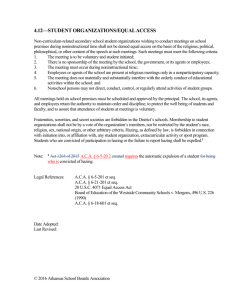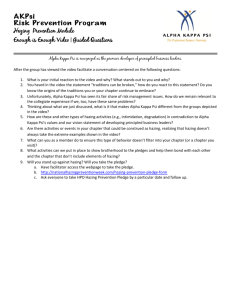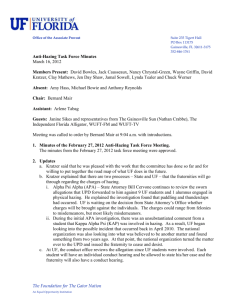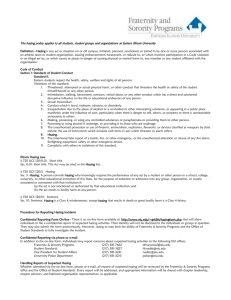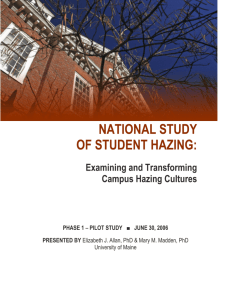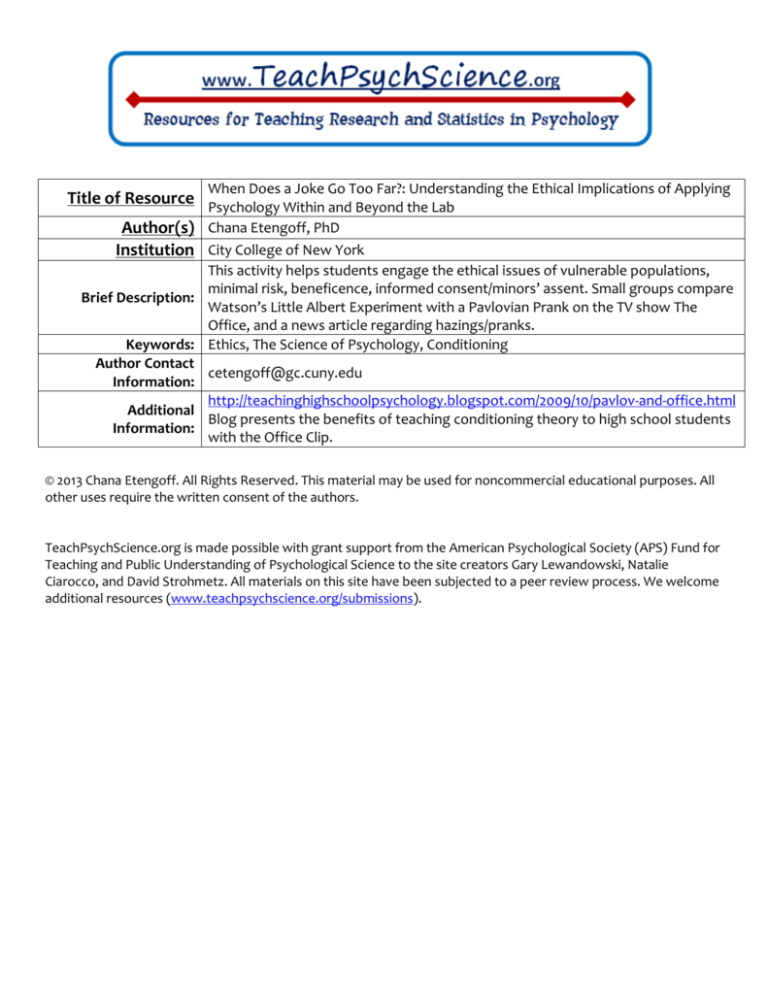
When Does a Joke Go Too Far?: Understanding the Ethical Implications of Applying
Title of Resource Psychology Within and Beyond the Lab
Author(s) Chana Etengoff, PhD
Institution City College of New York
This activity helps students engage the ethical issues of vulnerable populations,
minimal risk, beneficence, informed consent/minors’ assent. Small groups compare
Brief Description:
Watson’s Little Albert Experiment with a Pavlovian Prank on the TV show The
Office, and a news article regarding hazings/pranks.
Keywords: Ethics, The Science of Psychology, Conditioning
Author Contact
cetengoff@gc.cuny.edu
Information:
http://teachinghighschoolpsychology.blogspot.com/2009/10/pavlov-and-office.html
Additional
Blog presents the benefits of teaching conditioning theory to high school students
Information:
with the Office Clip.
© 2013 Chana Etengoff. All Rights Reserved. This material may be used for noncommercial educational purposes. All
other uses require the written consent of the authors.
TeachPsychScience.org is made possible with grant support from the American Psychological Society (APS) Fund for
Teaching and Public Understanding of Psychological Science to the site creators Gary Lewandowski, Natalie
Ciarocco, and David Strohmetz. All materials on this site have been subjected to a peer review process. We welcome
additional resources (www.teachpsychscience.org/submissions).
Instructors:
Please provide any instructions/tips/suggestions that would help instructors use this resource more effectively. If
possible, please also provide your best estimate of how long the resource will take in class.
Please paste your resource on the start of the next page. Thanks!
This activity is aimed at helping student engage ethical principles within the contexts of campus life,
popular media, and the research lab. This activity builds off of students’ experiential knowledge, leading to
their mastery of the definitions and application of the following terms: vulnerable populations, minimal
risk, beneficence, informed consent/minors’ assent. Although prior knowledge of classical conditioning
theory is not required, it may reduce the length of activity introduction. This activity generally takes a full
class period: Introduction of Activity (2-5 min.), The Office Altoid Prank Screening 2x (2 min), Little Albert
reading and Screening (15 min.), Small group discussion & handout completion (20 min.), Class
Discussion/Review (15 min.), Hazing News article and individual campus policy composition (10 min.).
Three materials are required for this activity:
1) Little Albert Reading: An excerpt regarding Watson’s Little Albert Experiment is provided from:
Harris, B. (1979). Whatever happened to little Albert?. American Psychologist, 34(2), 151-160.
2) Media Clips:
Little Albert Experiment: http://www.youtube.com/watch?v=Xt0ucxOrPQE
The Office Pavlov/Altoid Experiment: http://www.youtube.com/watch?v=nE8pFWP5QDM
Season 3: Episode 16 (Phyllis’ Wedding)
Based on Pavlov’s Classical Conditioning Theory, Jim offers Dwight an
Altoid every time the computer reboots and makes the bell sound.
Dwight then becomes conditioned to have a dry mouth when he hears
the bell.
3) Small Group Work Handout: Is Little Albert different than Dwight?
Students are provided with 5 short-answer questions to discuss and complete as a group. Group work
is then submitted for evaluation.
4) Individual Student Work Handout: When Does a Joke go Too Far?
This handout introduces the ethical implications of psychological anguish and misapplied theory within
the context of campus hazing rituals. Students are provided with Skorton’s (President of Cornell
University) 2011 New York Time’s op-ed: A Pledge to Attend Fraternity Hazing. Students are then asked
to craft a brief abstract introducing a campus policy that explains the ethical issues involved in
hazings/pranks that involve psychological distress. The abstract is submitted for evaluation.
Reference: Skorton, D.J., (2011). A Pledge to End Fraternity Hazing, New York Times, A23, August 24,
2011. Accessed on 5/17/2013 at http://www.nytimes.com/2011/08/24/opinion/a-pledge-to-end-fraternityhazing.html
I. Little Albert Reading
Harris, B. (1979). Whatever happened to little Albert?. American Psychologist, 34(2), 151-160.
II. Small Group Work Handout: Is Little Albert different than Dwight?
1. How did you feel when watching the Office Clip? Did you react differently to the Little Albert
Experiment? Why or why not?
2. Ethics & Participants: How does the age of the “subject” impact the ethics of their participation?
Should there be different standards for experimenting with children and adults? Why or why not?
3. Ethics & Consent: Is it ethical to conduct any type of experiment (i.e., feeding pieces of rat to
children) as long as the experiment is explained to the participant (informed) and they agree
(consent)? Why or why not?
4. Ethics & Risk: Is it reasonable to require experimenters to guarantee that participants will
experience absolutely no harm (i.e., stubbing a toe) during the course of their participation?
Describe the types of harm experimenters should be liable for and how they can be avoided.
5. Ethics & Context: Is it ethical to recruit participants to conduct a prank or a punk? When would it be
ethical to recruit subjects to participate in a study?
Answers/Discussion:
1. This first question offers students an opportunity to reflect on their initial emotional responses and
then unpack the underlying cognitions behind their emotions. Questions 2-5 then help students
situate their initial reactions within ethical theory.
2. After drawing on students’ experiential knowledge, the instructor can introduce the concept of
vulnerable populations as related to age (Example: Monster Study 1939 induced stuttering in
orphan children), disadvantaged groups (Example: Tuskegee Syphilis Study 1934-1972 withholding
medical advice to African-Americans with syphilis), prisoners (Example: Nazi medical experiments
1934), and individuals of varying abilities (Example: Willowbrook State School 1956-1971 infected
developmentally delayed children with Hepatitis to observe its untreated progression).
3. After reviewing students’ responses the instructor can build a discussion regarding the interaction
between age, comprehension, consent, and beneficence. A great case study to reference here is a
study by Keith-Spiegel and Maas (1981): 80% of participating children agreed to eat a bite of baked
mouse when they were told that it could save children from dying of hunger by the thousands and a
majority of children agreed to have their eye poked with a glass rod when the research aims were
presented as helping blind children see again. Fortunately, none of these actual experiments were
conducted. However, the study highlights the ethical concerns involved with consent and assent.
Reference: Keith-Spiegel, P., & Maas, T. (1981, August). Consent to Research: Are there developmental
differences? Paper presented at the annual meetings of the American Psychological Association, Los
Angeles.
4. After reviewing students’ responses the instructor can build a discussion around the issue of
“minimal risk” (normally associated with daily activities) in contrast to experimentally induced risks.
5. After reviewing students’ responses the instructor can discuss the importance of conducting a riskbenefit analysis and how IRBs determine what constitutes legitimate contributions to the field.
III.
Individual Student Work Handout: When Does a Joke go Too Far?
Every year, students on college campuses die from hazing rituals involving psychological and physiological risk.
Though Dwight’s dry mouth may have soon been extinguished, others may be traumatized or physically
harmed from conditioning pranks involving electrocution, fear, or dangerous stimuli such as poisonous snakes.
Although campuses are required to establish Institutional Review Boards to ensure ethical standards for
researchers, campuses are not federally obligated to develop hazing guidelines.
What would you do if you were Chancellor or President of your University to ensure that students on your
campus were only exposed to minimal harm, whatever the setting?
Individual Activity: Craft a brief abstract introducing a campus policy that explains the ethical issues involved
in hazings/pranks that result in psychological and physical harm. Be sure to explain your reasoning behind the
policy as well as how the policy will be enforced.
A Pledge to End Fraternity Hazing: By DAVID J. SKORTON Ithaca, N.Y.
IN February, a 19-year-old Cornell sophomore died in a fraternity house while participating in a hazing episode
that included mock kidnapping, ritualized humiliation and coerced drinking. While the case is still in the courts,
the fraternity chapter has been disbanded and those indicted in connection with the death are no longer enrolled
here.
This tragedy convinced me that it was time — long past time — to remedy practices of the fraternity system
that continue to foster hazing, which has persisted at Cornell, as on college campuses across the country, in
violation of state law and university policy.
Yesterday, I directed student leaders of Cornell’s Greek chapters to develop a system of member recruitment
and initiation that does not involve “pledging” — the performance of demeaning or dangerous acts as a
condition of membership. While fraternity and sorority chapters will be invited to suggest alternatives for
inducting new members, I will not approve proposals that directly or indirectly encourage hazing and other
risky behavior. National fraternities and sororities should end pledging across all campuses; Cornell students
can help lead the way.
Why not ban fraternities and sororities altogether, as some universities have done? Over a quarter of Cornell
undergraduates (3,822 of 13,935 students) are involved in fraternities or sororities. The Greek system is part of
our university’s history and culture, and we should maintain it because at its best, it can foster friendship,
community service and leadership.
Hazing has been formally prohibited at Cornell since 1980 and a crime under New York State law since 1983.
But it continues under the guise of pledging, often perpetuated through traditions handed down over
generations. Although pledging is explained away as a period of time during which pre-initiates (“pledges”)
devote themselves to learning the information necessary to become full members, in reality, it is often the
vehicle for demeaning activities that cause psychological harm and physical danger.
About 2,000 alcohol-related deaths occur each year among American college students. Alcohol or drug abuse is
a factor in more than a half-million injuries each year — and also in sexual and other assaults, unsafe sex, poor
academic performance and many other problems.
At Cornell, high-risk drinking and drug use are two to three times more prevalent among fraternity and sorority
members than elsewhere in the student population. During the last 10 years, nearly 60 percent of fraternity and
sorority chapters on our campus have been found responsible for activities that are considered hazing under the
Cornell code of conduct.
Why would bright young people subject themselves to dangerous humiliation? Multiple factors are at play: the
need of emerging adults to separate from family, forge their own identities and be accepted in a group;
obedience to authority (in this case, older students); the ineffectiveness of laws and other constraints on group
behavior; and organizational traditions that perpetuate hazardous activities.
Alcohol makes it easier for members to subject recruits to physical and mental abuse without feeling remorse
and to excuse bad behavior on the grounds of intoxication. It provides a social lubricant, but it impairs the
judgment of those being hazed and lowers their ability to resist.
Even more distressing, although 55 percent of college students involved in clubs, teams and organizations
experience hazing, the vast majority of them do not identify the events as hazing. Of those who do, 95 percent
do not report the events to campus officials.
Doctors, nurses and other student-health professionals have tried to address high-risk drinking and hazing
through individual counseling, a medical amnesty process that reduces barriers to calling for help in alcohol
emergencies, and educational programs. But the problem has persisted.
There are signs of progress. Jim Yong Kim, president of Dartmouth, has helped organize a multi-campus
approach to identifying the most effective strategies against high-risk drinking. The National Institute on
Alcohol Abuse and Alcoholism has established a college presidents’ advisory group to develop and share
approaches to this problem.
There is a pressing need for better ways to bring students together in socially productive, enjoyable and
memorable ways. At Cornell, acceptable alternatives to the pledge process must be completely free of personal
degradation, disrespect or harassment in any form. One example is Sigma Phi Epsilon’s “Balanced Man
Program,” which replaces the traditional pledging period with a continuing emphasis on community service and
personal development.
We need to face the facts about the role of fraternities and sororities in hazing and high-risk drinking. Pledging
— and the humiliation and bullying that go with it — can no longer be the price of entry.
David J. Skorton, a cardiologist, is the president of Cornell University.

